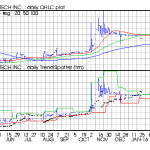We all have to make forecasts when it comes to investing. But how we develop those forecasts can be the difference between high probability outcomes and low probability outcomes. For instance, take a 30 year bond yielding 2.75%. No one really knows where that bond will be in 1 year. But we know that it will yield 2.75% per year for the next 30 years. So this instrument is really unpredictable in the short-term and becomes more predictable in the long-term.
Now, the same basic thing is true for the stock market. In my paper on portfolio construction I ran a heuristic technique to find the point of indifference in stocks using the current dividend yield. Running that model today gives us a duration of about 29 years for the stock market. In other words, the income stream of the S&P 500 is a lot like a 30 year T-Bond. But the bigger point is that the stock market is actually a long-term instrument. Just like our 30 year T-Bond, no one knows what it will do tomorrow or next year, but if you hold onto that instrument for the long-term we know it will generate positive returns with a high degree of certainty.
Of course, this puts us in a different pickle. Most of us don’t have realistic 30 year time horizons for some reason. Maybe you’re older. Maybe you need the cash flow before then. There are lots of rational reasons to avoid the theoretical concept of “the long-term”. But avoiding the long-term does not mean we should succumb to the constant urge to try to predict the very short-term. After all, we know that market timers do not predict the markets well and we also know that short-termism tends to increase taxes and fees.
This brings us to the hardest part of investing – finding your asset/liability mismatch and applying the right long-term instruments to meet your short-term cash flow needs. the difference between high probability outcomes and low probability outcomes, the longer you can stretch your time horizon the higher the probability of success. Finding this sweet spot and sticking to it is where the real alpha is made – your behavioral alpha and your ability to maintain a good portfolio that avoids the guaranteed frictions involved in trying to time the market too much.













Leave A Comment